Mandi Ehman's Blog, page 143
February 7, 2013
When Marriage Gets Tough

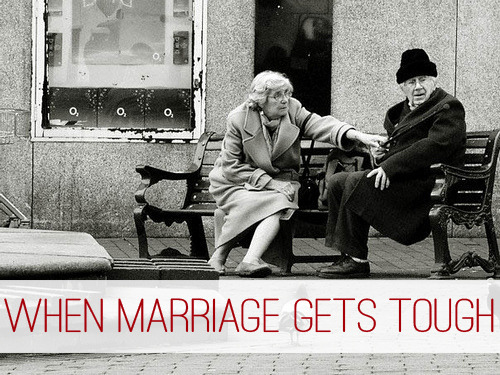
source: Tori Barratt Crane
Editor’s note: There are a lot of great posts in the archives here at Life Your Way that don’t get much attention anymore, so I’ll be sharing a couple of my favorites each week. This post was originally published in 2010, but I love to reread this story and remember how far we’ve come, and I hope it encourages you today as well!
Have you ever been at a place in your marriage where you wondered if you would make it? Or where you felt trapped because divorce was simply not an option but it seemed so hard to consider the future in relation to your present?
I have.
I should say we have, because I know Sean has felt these same things.
Marriage is hard work, and “they” tell you that all the time before you get married — your pastor and mentors and friends and books…they all tell you. But when you’re in love and have a dreamy-eyed view of marriage, it just doesn’t sink in what “hard” means. Sure, he’ll leave his socks on the floor, and I’ll just pick them up and put them in the basket. Sure, we fight sometimes, but it’ll be easier when we’re married. Sure, we both have baggage from our past, but we love each other, and that’s all that matters.
Ha.
If you’re married, I know you’re shaking your head right along with me. It doesn’t take very long for the truth to become apparent.
Our Story
I still remember our first fight after we were married.
I don’t remember what it was about, just that it was on the second day of our honeymoon. Two days as a married couple, and we already didn’t want to be in the same room. Off to a great start.
Things were good for a while. We took a cross-country adventure, moving to Utah for two years, and we started a family. But we also had a miscarriage, dealt with layoffs and some really tough financial times and faced the inevitable loneliness that happens when you move to a state where you literally know no one. Then we added a second baby, built a house and moved when I was eight months pregnant with our third daughter.
And that’s when things started to go downhill.
I was incredibly hormonal. The littlest thing set me off, and the angrier I got, the more Sean pulled away. Who could blame him, really?
Divorce was not an option for us, but I think we both wished it was at one time or another.
Hanging On
Somehow, though, while raising three little ones under three years old, we hung on. Barely, by the skin of our teeth, but the important part of the story is we hung on.
The turning point for us, looking back, was our decision to attend a marriage conference at church. If you know my husband, conferences are not his thing. At all. But he went, and for that I am incredibly thankful.
I don’t remember most of what was said at that conference, but as we stood in the doorway to the sanctuary with our fussy six-month-old, the female speaker told the story of her hormonal outbursts following the birth of their second child. She was weepy, angry, short-tempered and more (sound familiar?).
She said that her doctor told her that following the birth of each child, it takes your hormones an additional year to get back into balance. So your first child, one year. Second child, two years. Third child, three years. And so on.
I don’t know if that’s really true or not, but it resonated with me. She was put on a low dose of antidepressants and slowly things improved and they were able to work on the issues in their marriage without her hormones interfering.
After the session, we were sent out to walk around outside and just talk and reflect as a couple on the things we heard throughout the day. We made the decision then and there to call the doctor and schedule an appointment. Antidepressants weren’t something I really wanted to consider while still nursing, but something had to change.
Healing
As it turns out, I never made the appointment.
For me, acknowledging the cause of our issues — and having my husband understand that it was really, truly a biological, hormonal issue — was enough for us to start the healing process.
But if it hadn’t changed? I would have gone, and I would have accepted the prescription slip. This may not be a popular thing to say, but I would have even weaned the baby in order to save my marriage, if that’s what it had taken.
Thankfully, it didn’t take that, and slowly we started to heal.
And Now
Today, three-and-a-half years later, I am incredibly, head-over-heels in love with my husband.
He is an amazingly supportive guy, a wonderful dad and my best friend. He walks into a room and my heart skips a beat. And my girls roll their eyes several times a week when I tell them how much I love their daddy.
It didn’t happen overnight, but I am so thankful that we not only “stuck it out” but actually made a decision to seek help.
I say this, not to gloat, but to encourage you. If things are tough in your marriage right now, there is hope.
There’s hope.
Are you looking for ways to strengthen or save your marriage? Be sure to check out this bundle of marriage ebooks at BundleoftheWeek.com (available until 8am EST on 2/11) plus this FREE Art of Love Relationship Series, featuring more than 50 marriage experts over 10 days of live webinars!

Mandi Ehman is the founder and publisher behind Life Your Way and the co-author of All in Good Time, as well as a wife and the homeschooling mom to four beautiful girls. She lives with her family on a little slice of heaven in wild, wonderful West Virginia and loves coffee, chocolate, easy meals, beautiful things and minimalist spaces.
When Marriage Gets Tough is a post from Life Your Way
© 2010-2013 Purple Martin Press, LLC | All rights reserved - This feed is provided for the convenience of Family Your Way subscribers. Any reproduction of the content within this feed is strictly prohibited. If you are reading this content elsewhere, please send an email to contact@yourway.net to let us know. Thanks.

Free Kindle Books {2/7/13}

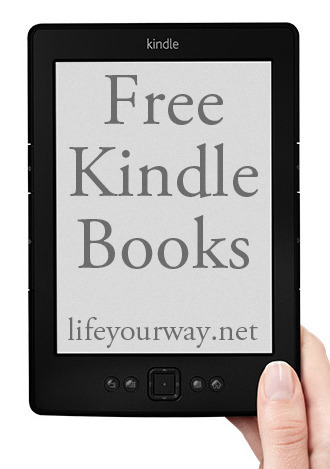
One of the most popular features of our sister site, Jungle Deals & Steals, are our free Kindle book lists. With 15-20 free ebooks every day, these are a great way to load up your Kindle without breaking the bank, and Kindle books can also be read on smartphones, computers and tablets with the Kindle app from Amazon.
Here’s a quick list of some of the freebies that are currently available, but be sure to head over to Jungle Deals & Steals for new freebies today…or subscribe to our daily freebies email so you don’t miss a single book!
Fiction
Death By A HoneyBee (Josiah Reynolds Mystery 1) (A Josiah Reynolds Mystery) by Abigail Keam
by Abigail Keam
Genre: Mystery
Reviews:  (91 reviews)
(91 reviews)
The Driving Lesson by Ben Rehder
by Ben Rehder
Genre: Contemporary
Reviews:  (35 reviews)
(35 reviews)
Maggie’s Journey (McKenna’s Daughters) by Lena Dooley Nelson
by Lena Dooley Nelson
Genre: Christian
Reviews:  (16 reviews)
(16 reviews)
Nonfiction
Spiritual Secrets To Weight Loss- Rev.: A 50 day renewal of the mind, body, and spirit by Kara Davis M.D.
by Kara Davis M.D.
Genre: Christian Living
Reviews:  (10 reviews)
(10 reviews)
Journey on the Hard Side of Miracles by Dr. Steven Stiles
by Dr. Steven Stiles
Genre: Faith
Reviews:  (49 reviews)
(49 reviews)
Immersion: Live the Life God Envisioned for You by Mark McNees
by Mark McNees
Genre: Inspirational
Reviews:  (46 reviews)
(46 reviews)
Time Management: A Holistic Approach by Michael Jibrael
by Michael Jibrael
Genre: Time Management
Reviews:  (8 reviews)
(8 reviews)
Children’s Books
The Day the Sun Slept In by A.J. Cosmo
by A.J. Cosmo
Genre: Literature
Reviews:  (1 reviews)
(1 reviews)
Wild Animals: Learn and Play by Jon Haws
by Jon Haws
Genre: Animals
Reviews: No Reviews Yet!
77 Funny Things That Kids Say by Faye Gray
by Faye Gray
Genre: Parenting & Families
Reviews:  (2 reviews)
(2 reviews)
See more Kindle freebies here.
Free Kindle Books {2/7/13} is a post from Life Your Way
© 2010-2013 Purple Martin Press, LLC | All rights reserved - This feed is provided for the convenience of Money Your Way subscribers. Any reproduction of the content within this feed is strictly prohibited. If you are reading this content elsewhere, please send an email to contact@yourway.net to let us know. Thanks.

February 6, 2013
How to Froth Milk Without Any Special Equipment

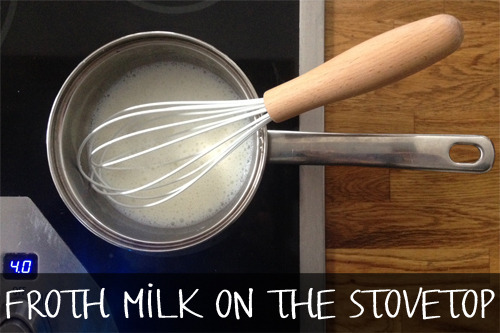
My next post in our Quick Tips from a Minimalist Kitchen is up at Easy Homemade, and this time I’m sharing my secret for perfectly frothed milk without any special equipment PLUS the recipe for my very favorite cinnamon latte:
I pretty much consider coffee to be one of life’s greatest simple pleasures, and over the past year, that’s evolved from a love of coffee in general to a love of lattes in particular.
My husband surprised me with an inexpensive latte maker last year, and while it makes a tasty espresso, the milk steamer/frother is just meh. (And I actually just replaced the latte maker with a more versatile gadget, but more on that another day!)
For a while I tried just adding cold milk to my espresso, but lukewarm lattes aren’t quite as tasty as their hot counterparts, and I began looking into alternatives for steaming and frothing my milk.
How to Froth Milk Without Any Special Equipment is a post from Life Your Way
© 2010-2013 Purple Martin Press, LLC | All rights reserved - This feed is provided for the convenience of Food Your Way subscribers. Any reproduction of the content within this feed is strictly prohibited. If you are reading this content elsewhere, please send an email to contact@yourway.net to let us know. Thanks.

Printable Routine Chart for Kids

The following post is from Jason & Jennifer Bruce of New Season Design :
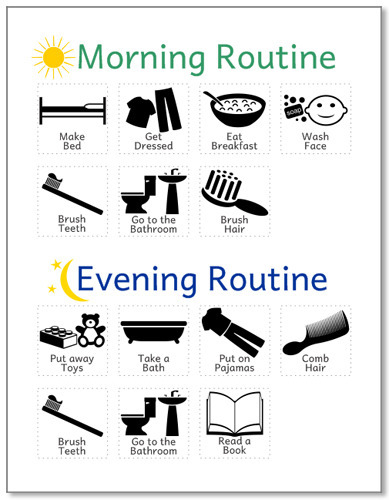
One of the things I’ve enjoyed about our daughter Emma growing up is that she’s able to take on more responsibility for her routines with each passing year. All I have to do after breakfast is tell her to take care of her “morning stuff,” and she knows exactly what tasks I’m asking her to do.
Of course, that scenario is the result of years of teaching and practice. If you have younger children and would like to start them on the road to self-directed routines, try this printable Routine Chart.
The first page has spaces for both morning and evening routines. The second page has visual reminders of which tasks kids should be doing. You can cut out the ones that apply to your family and place them in any order under morning or evening. Hang the finished chart when the kids can see it, and they’ll be able to self-monitor their routines.
Hopefully this tool will help you guide your kids to self-directed routines too!
Click here to download or print the printable routine chart.
What’s the most important part of your morning or evening routine?

Jason & Jennifer Bruce are the husband-and-wife design team behind New Season Design, where they work together to help clients put their best foot forward online. Jason is a pastor-turned-graphic designer, and Jennifer is a teacher-turned-blog designer who also blogs at The Simple Penabout life, learning and the things she loves.
Printable Routine Chart for Kids is a post from Life Your Way
© 2010-2013 Purple Martin Press, LLC | All rights reserved - This feed is provided for the convenience of Family Your Way subscribers. Any reproduction of the content within this feed is strictly prohibited. If you are reading this content elsewhere, please send an email to contact@yourway.net to let us know. Thanks.

Buy a Shirt & Help Teenage Burn Victims {Sevenly.com}


Have you discovered Sevenly yet? Sevenly offers a new shirt design each and every week, but these designs aren’t just pretty — they’re designed in support of a specific cause or charity, and $7 from each shirt sold is donated directly to that charity!
This week’s charity is Angel Faces Retreats, whose mission is to provide healing retreats and ongoing support for adolescent girls with burn/trauma injuries. Each shirt purchased this week provides trauma counseling, therapy and emotional support to help these girls feel beautiful in their skin.
See all of this week’s designs here.
Why Sevenly?
Sevenly is a for-profit company that is making a tangible difference through their giving. They offer high-quality, stylish clothing at a reasonable price and instead of pocketing all of the revenue, they give $7 from each and every shirt purchased directly to the cause of the week.
While giving directly to a charity is always the better option, Sevenly is a great way to expand your wardrobe and support the causes you care about at the same time. And your new shirt offers you the opportunity to become an ambassador for these charities as well, as the designs are sure to open up conversations along the way!
Buy a Shirt & Help Teenage Burn Victims {Sevenly.com} is a post from Life Your Way
© 2010-2013 Purple Martin Press, LLC | All rights reserved - This feed is provided for the convenience of Family Your Way subscribers. Any reproduction of the content within this feed is strictly prohibited. If you are reading this content elsewhere, please send an email to contact@yourway.net to let us know. Thanks.

Peanut Butter Cookies: It Goes Beyond Baking
 The following post is from Shaina of Food for My Family and Olmanson Photography:
The following post is from Shaina of Food for My Family and Olmanson Photography: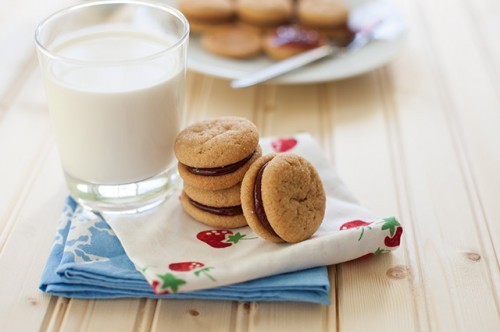
source: Shaina Olmanson | Food for My Family
We were sitting at the dinner table, soup in front of us after a long day. A day off school. I had pulled the soup together in minutes while the kids were playing downstairs, just trying to get it simmering before I needed to run out in the snow, braving rush-hour traffic that creeps along exponentially slower the heavier the flakes falling.
That’s when she said it. My six-year-old told me she was sad that I had made dinner without her. Disappointed that I hadn’t included her when she was home, available, and willing.
As a parent, I realize how there are these thin areas in the timeline of our children’s childhood. They are marked by their willingness to do certain activities, and if left alone and ignored, those strips of color where your children are genuinely excited and willing will fade, their color not bleeding over into the length of life yet to live. But if you plant little seeds and care and nurture them, those colors will bloom and brighten.
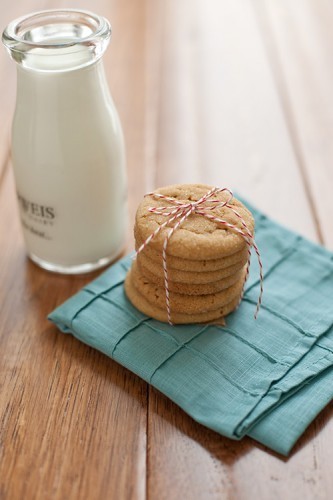
source: Shaina Olmason l Food for My Family
Today we made peanut butter cookies, my daughter saddled up next to the counter, her favorite apron tied around her waist. She delighted in cracking eggs, in watching the mixer spin, in rolling the dough around in the sugar. And we baked together the way I used to when I was sweet and innocent, sitting on my mom’s counter as we turned ingredients into memories and seeds of life.
Basic Peanut Butter Cookies
Recipe type: dessert
Author: Shaina Olmanson | Food for My Family
Prep time: 20 mins
Cook time: 8 mins
Total time: 28 mins
Tiny peanut butter and jelly sandwich cookies make a great after-school snack for small mouths.
Ingredients
1 cup creamy peanut butter
1 cup unsalted butter
1 cup brown sugar
1/2 cup granulated sugar
2 eggs
1 teaspoon vanilla
3 cups all-purpose flour
1 1/2 teaspoons baking soda
1 teaspoon baking powder
1/4 teaspoon salt
Additional granulated sugar for rolling
For sandwiches: 1/3 cup strawberry jam
Directions
Preheat your oven to 375º F. In a large mixing bowl or mixer, cream together the peanut butter, butter, and both sugars. Mix in the eggs and the vanilla until well mixed.
In a separate bowl, whisk together the flour, baking soda, baking powder, and the salt. Mix in the flour with the peanut butter mixture.
Roll the dough into 1″ balls, and then roll each ball in the additional granulated sugar to coat. Place the balls on a lined baking sheet, 2″ apart. Gently flatten slightly with a fork or the bottom of a glass.
Bake for 6-8 minutes until center of the cookies are set. Remove from the oven and allow to cool slightly.
To make sandwiches: Make the balls slightly smaller, about 3/4″, when baking. Warm the jam in a small saucepan on medium heat. Spread warm jam onto the back of cooled cookie, topping with a second. Allow the jam to cook, which will set it.
2.2.8
Do you do something special for your little Valentines?

Shaina Olmanson is the home cook and photographer behind Food for My Family and the author of Desserts in Jars: 50 Sweet Treats that Shine. She is a contributor to Babble.com’s Family Kitchen Blog and the food channel on Lifetime Moms. Shaina can usually be found cooking, at the computer or behind the camera.
Peanut Butter Cookies: It Goes Beyond Baking is a post from Life Your Way
© 2010-2013 Purple Martin Press, LLC | All rights reserved - This feed is provided for the convenience of Food Your Way subscribers. Any reproduction of the content within this feed is strictly prohibited. If you are reading this content elsewhere, please send an email to contact@yourway.net to let us know. Thanks.

February 5, 2013
DIY Valentine’s Day Wreaths


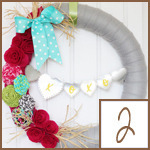
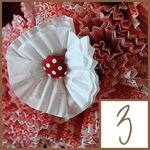
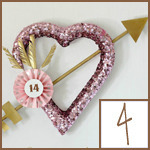


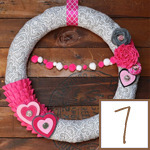


Decorating with a fun, whimsical wreath is a fast and easy way to celebrate Valentine’s Day. Whether you like over-the-top fancy and layered designs or simple and clean, wreaths are a great do-it-yourself project because they can be made from just about anything you can imagine.
The blogosphere is hopping with a lot different of Valentine’s Day wreaths. I’m amazed at how many creative items you can use to create and decorate wreaths. Today, I’m sharing nine unique Valentine’s Day wreaths that have caught my eye:
1. Heart Argyle Valentine’s Wreath
2. Felt Valentine’s Wreath
3. Cupcake Line Wreath
4. Cupid’s Arrow Wreath
5. Yarn Wrapped Valentine’sWreath
6. Spiral Rose Burlap Wreath
7. Pink & Gray Valentine Wreath
8. Valentine’s Heart Willow Wreath
9. Scrappy Valentine’s Day Wreath

Myra has a B.A. in Interior Design and is currently self-employed. When she’s not spending time with her little man, thrifting, creating, shopping or working on a project, Myra enjoys date nights with her husband and blogging at My Blessed Life.
DIY Valentine’s Day Wreaths is a post from Life Your Way
© 2010-2013 Purple Martin Press, LLC | All rights reserved - This feed is provided for the convenience of DIY Your Way subscribers. Any reproduction of the content within this feed is strictly prohibited. If you are reading this content elsewhere, please send an email to contact@yourway.net to let us know. Thanks.

The Problem with “Natural” Products

The following post is from Emily of Live Renewed:
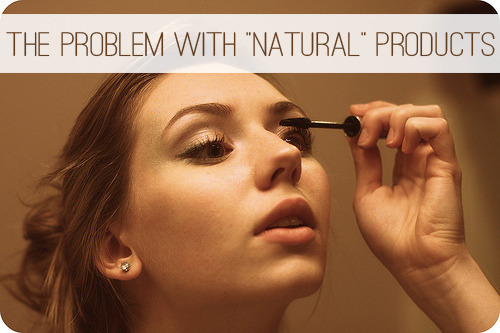
source: Alex
Editor’s note: There are a lot of great posts in the archives here at Life Your Way that don’t get much attention anymore, so I’ll be sharing a couple of my favorites each week. This post was originally published in 2011, but it’s just as true today as it was then!
How many personal-care products do you use on a given day? Three, five, ten…more?
Do you know what’s actually in the products you’re smoothing on your skin, putting in your hair, or spraying around yourself and then inhaling?
The average person uses ten personal care products every day, and most don’t even realize the cocktail of chemical ingredients they are exposing themselves to on a daily basis. There is a growing number of people, though, who are becoming more informed and concerned about the products they use.
Are You Informed?
Organizations like the Evironmental Working Group and Healthy Child, Healthy World are helping to spread the word about the effects that toxins have on our environment, our bodies, and our children.
As consumers become more aware of the issues with personal care products and the lack of testing done on ingredients regularly used in conventional products, the companies that make these products are catching on too.
Have you noticed that words and phrases like “natural”, “pure”, “naturally derived”, and “organic” are becoming more and more popular on all different types of cosmetics and personal care products? Did you also know that there are NO regulations over labeling on personal care products? So basically, a company can slap any word or phrase they like on their products to make them more marketable and more attractive to the consumer.
Are You a Conscious Consumer?
It is very important to be a conscious consumer as we choose and use personal care products on ourselves, and also on our children, whose little bodies are more affected by the toxic ingredients found in so many conventional products. Whether you set a green goal for the new year, or are just ready to change your personal care products, here are some tips for making sure that the products you use are safe for you and your family.
Don’t be fooled by claims and labels.
Even though a product claims to be natural, pure, or organic; it might not be. “Greenwashing” is when a company makes their products seem more safe, natural, and green, simply to market them to consumers who are trying to “go green”.
Make your own beauty products at home.
The best way to know exactly what’s in your products is to make homemade beauty products. I use homemade deodorant, the oil cleansing method for washing my face, and have made homemade lip balm and healing salve. I love their short and safe ingredient lists.
Familiarize yourself with toxic ingredients.
You need to know what to look for when you’re reading the product label. When you know which ingredients to avoid, you will be able to make good buying decisions. The cosmetic database has a helpful printable guide with a list of toxic ingredients and products, and remember to avoid these toxic ingredients in your personal care products.
Read the Ingredients.
Before you purchase a personal care product, be sure you read through the list of ingredients on the back — just like you should do with food. One rule of thumb I have heard is, if you don’t know how to pronounce any of the ingredients, you shouldn’t buy it, but I think that can be misleading because there are some perfectly safe ingredients that have long or chemical sounding names.
By intentionally seeking out and buying personal care products that are truly safe and natural, you are voting with your dollars; telling companies that it IS important to use safe ingredients, and not just market their products by slapping a misleading label on them to make them more appealing.
Do you read the labels on your personal care products? How do you “vote with your dollars” for beauty products and other products?

Emily McClements is passionate about caring for God’s creation while saving money at the same time. She is a blessed wife and mama to two young children, and blogs about her family’s journey toward natural and simple living at Live Renewed.
The Problem with “Natural” Products is a post from Life Your Way
© 2010-2013 Purple Martin Press, LLC | All rights reserved - This feed is provided for the convenience of Green Your Way subscribers. Any reproduction of the content within this feed is strictly prohibited. If you are reading this content elsewhere, please send an email to contact@yourway.net to let us know. Thanks.

Six Benefits of Music Lessons for Children

The following post is from Angie of Many Little Blessings:

source: JoshSemans
As a life long lover of music, it was an easy decision to make to set aside money every month for each of our children to take some type of music lessons. While I wouldn’t want to add up what that has meant that we’ve spent on those lessons over the last several years, I would venture a guess that I would still say that it has been worth it to hear beautiful piano and cello music around our home.
While our personal enjoyment of hearing the music is certainly a benefit of the children taking lessons, there are also many other wonderful benefits for them.
Six Benefits of Music Lessons for Children:
1. Studying music can be an extra history lesson.
Given the right music teacher, there will inevitably be discussions about where the music came from, the setting under which it was written, or more information about the particular composer. My son that is extremely interested in history will often tell us all about the background of the music, and how it came to be because his teacher knows that is something that sparks his interest in the music.
2. Learning to play is a lesson in perseverance.
For anyone that has ever learned an instrument, you will well know how much perseverance is required to even get to the point where you can play one song that someone can recognize, much less to actually become proficient at your chosen instrument. It’s good for character growth to have to sometimes struggle to meet a goal.
3. Playing music can instill a sense of pride.
Once a child can play their instrument, even if it’s just one song, they are able to feel a real sense of accomplishment. This is also a great chance for character building.
4. Learning an instrument can offer a chance for individuality.
With homeschoolers often studying some of the same subjects and doing many of the same projects, taking music lessons can offer them a chance for individuality, as long as they are given a chance to choose their own instrument. At our house, each child was able to choose their own, even if it meant that my middle child wasn’t well suited for his instrument of choice and then moved onto a different one.
5. Music lessons are an opportunity for responsibility.
I have taken what might be an unconventional approach to music lessons in our home. I make sure that the kids practice each day because I write it in their assignment book. However, beyond that, it is all their responsibility. They are the ones that make sure they have practiced the right pieces, and that they are doing everything they should be doing.
It has happened that this approach has been a chance for them to learn. For example, just this week at cello lessons, we found out that while my daughter had been practicing all week, she hadn’t been practicing newer pieces. Instead of following the notebook that her teacher wrote in for her, she had just been trying to remember what to play. After a very kind talking from her teacher, I suspect that my daughter will always remember to check the notebook before practicing each day.
6. Lessons can increase music appreciation.
If my children take nothing else away from music lessons than an appreciation for the beauty and joy of music, then that will be worth it to me. In a busy, electronic world, it’s nice to take time to enjoy some of the beautiful things, like music.
Do your children take any type of music lessons? If so, what instrument do they play?

Angie, a domestically-challenged writer and artist, is a homeschooling mom to three children. She writes about everything that happens in their lives between all the loads of laundry at Many Little Blessings. She is also the founder of The Homeschool Classroom, Catholic Mothers Online, and Just a Tiny Owl.
Six Benefits of Music Lessons for Children is a post from Life Your Way
© 2010-2013 Purple Martin Press, LLC | All rights reserved - This feed is provided for the convenience of Family Your Way subscribers. Any reproduction of the content within this feed is strictly prohibited. If you are reading this content elsewhere, please send an email to contact@yourway.net to let us know. Thanks.

The Unplugged Life: Enlightening or Reckless?

The following post is from Michelle of Mommy Misadventures:

source: FreeDigitalPhotos.net
I recently read an article in Sunset Magazine that featured a San Francisco family that chooses to live life almost completely unplugged. The Mission District home of Donovan Corliss and Laura Jo Wegman is almost suspiciously devoid of most of the modern conveniences one would associate with the technology mecca that is San Francisco. Their home contains very little technology: no TV, no laptops, no LED screens, not even a microwave.
Corliss and Wegman are proponents of a movement known as “unplugging”; believing that technology is a distraction, they eschew it in order to make more meaningful connections in life.
It’s well worth the read to learn more about the unplugging movement. Choosing how much technology you allow in your life is a very personal choice, and one that I think everyone should contentiously make. And because I am such a tech proponent, I think consciously chosen “unplugged” periods are essential to developing a good tech/life balance. There’s no rule that mandates that modern life has to be lived with a smartphone.
But as a parent, this statement by Donovan Corliss is what really got my attention: “I think TV and Internet and phones become such a time suck that people feel that they don’t have time for anything else.” [...] “They don’t have time to do artwork with their kids or read books or have a conversation with one another.”
As a tech geek who has dreamt of the convenience of the Internet at the palm of your hand since, oh, the mid-1990s, I find statements like Corliss’ to be presumptious and hurtful. Just because I choose to use the Internet doesn’t mean that I don’t make the time to sit down and do an art project with my daughter or have meaningful conversations with my husband. How many times have I found an awesome art project online because of sites like Pinterest which I then did with my daughter? How many times have I read something online that I immediately sparked an animated debate between my husband and I?
While I agree with the importance of “unplugging”, I fundamentally reject its core philosophy that technology hinders meaningful connections in life. I believe that technology is a distraction to daily life only if you let it become one.
Corliss and Wegman both admit to having iPhones and laptops but keep their children’s exposure to it as minimal as possible. In the effort to shield their children from the negative aspects of technology, they also deprive them of the opportunity to learn how to become responsible tech users. Technology is only going to become more accessible and more prevalent in daily life from here on in. Depriving a child from learning how to use technology responsibility now may only backfire in the future.
Rather than shield my daughter, I choose to allow her to embrace it, to understand that technology is a tool that can open countless doors, both virtual and real. I hope to instill good usage habits that will allow her to make informed, contentious usage decisions as technology continues to evolve. Here are three ways to help instill good computer usage habits in your children:
Set a good example.
As parents, it is our responsibility to set the example for our children. If you don’t want your children to grow up to be tech-zombies, then it has to be you to set the example for them. Make the most of the time when screens aren’t allowed.
Turn off your gadgets when you are with the family. Keep your smartphone in your purse while you’re at the playground, use your tablet only at designated times at night. Your own responsible gadget use will be show your kids that when you are there with them, you’re there with them.
Set realistic limits for your family AND yourself.
Create limits for screen time for your children. The American Academy of Pediatrics recommends that children over the age of 2 be limited to 1 to 2 hours of screen time per day. Furthermore, the AAP recommends that children under the age of 2 not be exposed to television at all.
In our family, we have chosen not to strictly follow the AAP’s recommendations. We allow our daughter 1 to 2 hours of non-interactive media watching every day but allow her another 1 – 2 hours of active, supervised interactive screen time for educational video games or web sites. We also limit the times of day she can watch her non-interactive media. It sounds like a lot but she rarely reaches that limit. Despite having liberal access to TV and interactive devices, she most often chooses other activities — mostly art projects or just free play.
If you set tech limits for your children, be sure to set some for yourself as well. These can be as simple as “no smartphone between the hours of 5:00 and 8:00PM” to allow yourself more, meaningful time with your family.
Use technology with your family.
Take an active role in your child’s device use. Evaluate the apps before giving them over to your child so that you know what they are playing.
Leaving children to their own devices – and I do mean that literally, as in a parent will hand over the tablet and let the kids go at it – is a Bad Idea ™. This is how screen zombies are made, how children get sucked into the addictive vortex of animated sight and sound.
Understand how your child is going to use the device. If you have a younger child, use the device with them. My daughter’s active screentime is often spent in my lap as she doodles around on the iPad. Games and interactive story books can be used in much the same way as traditional story books. Do you cuddle with your child when you read to them? If so, there’s no reason that cuddling with your child as they use a tablet or other device should be any different. Encourage your young child to be active and engaged when they are playing. Repeating words or talking about elements of game play while using the device is essential.
If you have an older child, ask yourself: do you know what’s on their tablet? Their phone? Their computer? If the answer is no, it is your responsibility to find out. What does the app do? What does your child use it for? Is the content and purpose appropriate for your family?
What are your thoughts on technology in daily life? Is it really a hindrance or are you allowing it to become one?

Michelle Mista is an IT professional, writer and blogger with a love for all kinds of technology. She writes about tech tips and trends for work at home professionals on her portfolio blog and muses about motherhood at Mommy Misadventures. She is on the constant quest to balance life, work and geekery.
The Unplugged Life: Enlightening or Reckless? is a post from Life Your Way
© 2010-2013 Purple Martin Press, LLC | All rights reserved - This feed is provided for the convenience of Tech Your Way subscribers. Any reproduction of the content within this feed is strictly prohibited. If you are reading this content elsewhere, please send an email to contact@yourway.net to let us know. Thanks.






